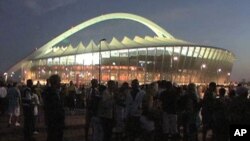Although the 2010 Football World Cup ended nearly six months ago, many people in South Africa are still basking in warm memories of the event, and most say it was the highlight of the year. For the organizers and the South African government it was the culmination of years of hard work.
People in South Africa still recall the excitement of hosting the first football World Cup in Africa. In the days before kick-off the high spirits often boiled over into marches and parades.
"Feel it. It is here," one man said. "I am getting excited about the World Cup."
In December Tourism Minister Marthinus van Schalkwyk presented a report saying more than 300,000 foreigners came to South Africa for the month-long tournament and spent one-half billion dollars during their stay.
"The success of this World Cup will reverberate for years to come," he said. "It has enhanced our reputation as a destination that has the ability to host events like this, major sporting events, conventions, but also for leisure tourists. So, [it is] a success story."
He said the greatest proportion of foreign fans, 38 percent, came from Africa, followed by Europe and the Americas.
When broken down by country, he said the largest number of foreign fans, more than 30,000, came from the United States, followed by Mozambique and Great Britain.
The report said nearly 60 percent of the World Cup visitors were coming to South Africa for the first time and 80 percent said it was their first World Cup.
Among those who had attended a previous World Cup, half said the 2010 tournament was the best ever. And nearly 90 percent of all those polled said they would consider a return visit.
The head of the Organizing Committee, Danny Jordaan, said the World Cup provided an opportunity to showcase South Africa as a world class tourist destination.
But he said a major purpose was to foster national reconciliation and unity after years of inequality and discrimination under apartheid.
"We are a nation that comes from divided past, a past of conflict, almost of war," he said. "And so the building of new single non-racial South Africa is a critical part of sustainable economic growth, of deepening and strengthening democracy in our country."
The World Cup also provided an incentive to invest in infrastructure.
The government over four years spent an estimated $12 billion on new stadiums, airports, roads and railways. And it spent $160 million on security, including crowd control training, new equipment and special courts for law-breakers at World Cup sites.
Tourism Minister van Schalkyk said the investment was worth it.
"Looking back at the World Cup, as South Africans we can now say with a clear conscience that it has been worth every cent," he said. "It has been worth every ounce of energy and it has been worth every minute of our time, undoubtedly."
More than three million tickets were sold to the Cup's 64 matches, the third-highest attendance in history after the United States in 1994 and Germany in 2006.
Hundreds of thousands of fans watched the matches on giant screens at fan parks around the country. And millions more watched them on television in cafes or at home.
And there was a focus on civic responsibility and legacy. The football governing body, FIFA, sponsored the Football for Hope tournament that brought together disadvantaged youths from nearly 40 countries for an alternate tournament.
And FIFA opened the first of 20 Football for Hope centers in Africa. These seek attract disadvantaged youth through football in order to provide them with training in health, nutrition and social coping skills.
For the government the World Cup served to build national unity and showcase South Africa's hospitality, tourism and organizational ability. For fans it provided memories of a lifetime.










